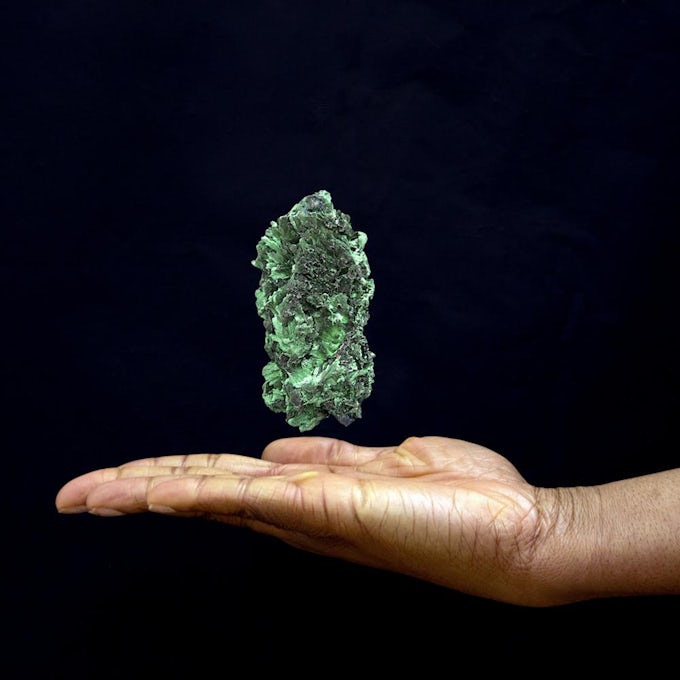
I have always loved a particular blue. It is a blue that hovers between royal and azure. A blue that appears almost luminescent, glowing, yet containing a certain depth. As Maggie Nelson writes, in relation to a slightly different hue, ‘That this blue exists makes my life a remarkable one, just to have seen it’.01 It is a blue that gives me a sheer, visceral delight. A blue with the power to arrest a gaze. Cobalt blue. It is a blue fundamentally of the earth, from inside the earth. Like indigo, it links us to soils, and under them, to mineralogical foundations. It is elemental; a terrestrial blue, it is different, but related to, the expanses of the sea or the sky. However, when you dig cobalt out of the ground it is not blue, but is rather shiny, grey, crystalline, with a tinge of dark chocolate. It looks like what comes immediately to mind when I think ‘mineral’. In order for it to become blue, cobalt is transformed from the chemical element Co, to cobalt aluminate and cobalt stannate – words entirely inadequate and clinical, too precise for the richness of feeling that they produce.
Cobalt is a startlingly pervasive metal, appearing infrequently as this particular pigment. It is used in an array of applications and products, as superalloys to produce blades for gas turbines and jet engines, and as a catalyst in household items such as paints, varnishes and inks. It is particularly coveted by the military because of its use in the creation of magnetic steel alloys. Cobalt is now most widely used in the production of lithium-ion batteries, which power our smartphones, computers and electric cars. It is a fundamental material of the ‘green’ revolution. Most of the global supply of cobalt, approximately 60 per cent, comes from the Democratic Republic of Congo (DRC).02 There, an estimated 100,000 people dig this metal out of the earth by hand, with few safety measures and little oversight, at huge cost to their health and well-being. 03 As Alberto Acosta, economist and former minister of energy and mines in Ecuador, makes clear, the presence of vast natural resources in formerly colonised countries often contributes to, rather than ameliorates, poverty. Economies primarily based on extraction exacerbate global inequity as the resources are usually sold to foreign companies, who then refine and ship products overseas, creating wealth for very few and mostly international owners while the locales of mining are left with the social and environmental costs – a phenomenon deemed the ‘resource curse’.04

Mary Mattingly has been exploring this particular metal for the past few years in various iterations in her artistic practice. Mattingly has long been interested in the de-alienation of objects, tracing everyday items back through supply chains to the ecologies and places where they are from. For example, in her project Own It (2013–ongoing), she carefully documents a number of personal items, from clothing to old CDs, which she offers to give away or provide copies of to anyone who is interested. For each item, she attempts to trace its path from its site of origin through the processes of production and distribution, drawing attention to how and where things are made, and at what cost, attempting to account for, and bear witness to, ecological extraction and human labour. She describes the project by saying that it is a ‘way to begin an extended funeral prayer, illuminating rituals and tragedies embedded in objects in a precarious world’.05 Mattingly became interested in cobalt when she realised that it was an essential component for photographic processes as it appeared in both the lens of her medium-format Hasselblad and the battery of her digital camera. In this way, Mattingly turns the relations of extraction back to the medium of photography itself. The starting place for Mattingly’s project importantly links extraction and visuality through this compelling and seductive metal, manifesting often as colour.

‘Extraction’, according to the Oxford English Dictionary, is defined primarily as ‘The action or process of drawing (something) out of a receptacle; the pulling or taking out (of anything) by mechanical means’. It has come, in these ecocidal times, to more specifically refer to the deathly processes of colonial capitalism, extracting labour from bodies, minerals and oil from the ground, trees and water from the land, fish from the sea. Extractivism is the term now commonly used, emerging from Latin American scholarship, to describe the commodification of the earth. As Acosta defines it: ‘Extractivism is a mode of accumulation that started to be established on a massive scale five hundred years ago. The world economy – the capitalist system – began to be structured with the conquest and colonisation of the Americas, Africa and Asia.’06 Extractivism, in other words, describes both an ideology and an economic system built on the understanding that the world, and all its beings, are inherently commodifiable, violently turned into ‘things’ operating as a standing reserve for the accumulation of profit and power in the hands of a few. It describes the mutual entwinements of colonialism, capitalism and ecocide. The devastating impacts of this ideology are not hard to find.
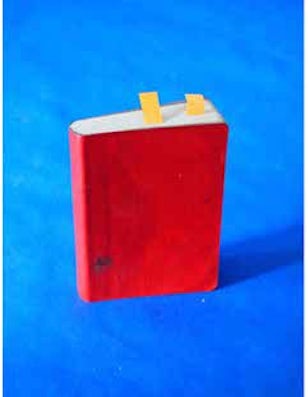
In contemporary times, as Mattingly implicitly argues in her work, the processes of visualisation and extractivism are intimately linked. Keeping to the example of cobalt, we can see the circular ways in which particular systems of visualisation and extractivism reinforce each other. Mined from the DRC, Australia, Canada or elsewhere, cobalt is frequently embedded in drones, which are then used not only for military, corporate and leisure activities, but also by mining and oil companies, looking for new areas to plunder. Drone and satellite technology are increasingly used by extraction companies to reduce exploration costs. Macarena Gómez-Barris describes how modern states ‘coordinate with multinational corporations, using reconnaissance systems to collect large data sets […] and produce high-resolution maps that are deployed to build extractive industries on the ground’.07In particular, the ‘“Five Eyes” states (United States, Canada, United Kingdom, Australia, and New Zealand) have increasingly invested in satellite technologies that support the planet’s mapping for military and surveillance purposes, as well as for the conversion of natural resources into commodities’.08 Cobalt, in other words, produces the means to extract more cobalt.
For Mattingly, cobalt becomes a way to speak simultaneously to the issues of the implication of extractivism in visual technologies as well as working through our personal investments, our tied intimacies, to these chains of violent exploitation. Mattingly’s engagement with cobalt has been expansive. For example, she has produced ever-shifting maps of its commodity chains, documenting where cobalt is mined, refined and sold to expand public knowledge. These maps are drawn in chalk to be able to respond to the whims of the market, for as prices go up and down, the circulation patterns of cobalt across the globe, alter. Mattingly has also employed collaborative processes to create exhibitions such as ‘What Happens After’ (2018), which involved an impressive restaging of a decommissioned army vehicle (that contained cobalt). The vehicle, a 19,000-pound light-medium tactical vehicle (LMTV, a military cargo truck), was taken apart and rearranged by 12 additional invited artists. This transformation of the truck involved sawing one of the tires in half, creating a stage out of the sides of the vehicle, and making a ‘door to nowhere’ from its housing. Mattingly’s investigations into cobalt also consist of photographs that depict sculptural assemblages, which register as domestic and formal simultaneously, staged as improbable still lifes. These smaller, more mundane photographic gestures offer a powerful reworking of the terms of extraction and our relations to mining in the West. They feature an array of objects, all of which contain, or possibly contain, cobalt. The objects are bound together, often with string, or sometimes just through proximity, and sit in front of various photographic backdrops. They offer what I like to think of as the intimacy of extraction; that is, they stage a process of care taking or making meaningful of objects that are otherwise taken for granted.
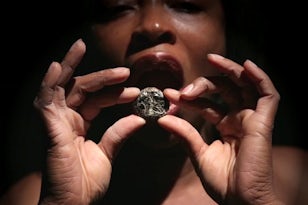
These photographs are, for me, an affective and material working through of the complicated and violent entanglements that we are caught in. The string that serves to bind objects together becomes a way to think through what Donna Haraway calls ‘string figures’.09 The materially entangled objects mirror how many of us feel caught in systems not of our own making, but from which we nonetheless benefit. They offer a kind of visual representation of our own, willing and advantageous, bondage. But instead of hand-wringing or denunciation, the work offers a way to think of these bloodied objects as parcels, opportunities for care. They offer a kind of ethical frame where outrage isn’t quite possible, because we are simply too close. They make us feel implicated, while side-stepping guilt. There is something in the production of these tableaux that offers an affective alternative, not to let us off the hook, or to dissuade from political lobbying or activism, but to show us the ways in which we are bound to the things we abjure. Whether we like it or not, we are composed of and dependent upon these complicated and violent global entanglements. There is, importantly, no innocence in these staged scenes. There is also no sense of removal. Instead, there is a working through of objects and legacies, a working with that expresses care for the objects themselves and our implication in their violence. The attention and centring of the objects allows them to both be otherwise, to re-draw the relations to the commodity chain of cobalt and its gross injustices, while also grouping them together precisely through this frame.
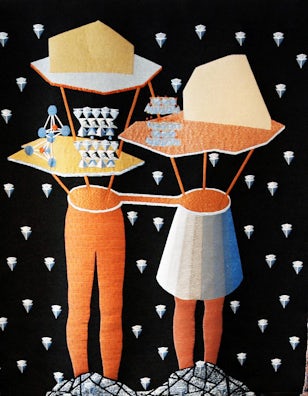
Otobong Nkanga works with a very different visual language, but with a similar ethic, to take up the entangled legacies of colonialism and extractivism in the examples of extensive open-pit mining. In her far-ranging projects that encompass installation, performance, drawings and video work, she expresses a playful fascination and biting critique of our mineralogical obsessions. Nkanga’s ambiguous yet deep relations to the metallic make her work vital in the era of extractivism. She foregrounds the holes and scars left by mining, and the attendant circulation of minerals throughout colonial empires. For her ongoing research on the cultural pursuit of bling, for example, Nkanga travelled across Namibia, following the path taken by four traders who settled at Otavifontein in 1875. She traced the colonial exploration of the land, repeating the journey, and arriving, finally, at what had been the Tsumeb mine. It was once a glistening hill, a vibrating green reflecting oxidised copper. A luminescent green, light but shining, that would have rivalled cobalt. And, its appearance above ground must have been remarkable. The video, Remains of the Green Hill (2015), that Nkanga made as part of this larger field of artistic enquiry, opens with a light shining, glinting in the distance in a darkened sky. As the sun comes up, and the land becomes visible, what is shown is an emptied hole. A decimated and scarred landscape where the wondrous hill used to be. Instead of this vibrant field of colour, there is instead a pit. It is an image of negative space; an absence that implies a lost presence, or, as Natasha Ginwala eloquently writes, ‘the refusal of shine manifests via its inversed figuration in the negative surface of civilizational excess’.10 Arriving at the edge of this pit, Nkanga begins a series of yoga-like poses on the site of the former mine, her figure backlit by the rising sun. The gestures could be read as an invocation of healing, of connection, deliberately breathing in the remains of the mineral air. The soundtrack consists of an interview she conducted with the mine’s last managing director, Andre Neethling. He speaks to the necessity of doing something with the mine, at least cleaning it up, or ‘build[ing] a nice little wall’. He implicitly argues that the open pit, encircled by a wall, could then be understood as a kind of monument, rather than the decimated remains of the imperial drive of extraction. In this work and others in the series In Pursuit of Bling (2014), Nkanga makes ‘explicit the connection between rarefication (of ore) and the desire to possess, which is central to the complex networks of supply and demand that define globalization’, as Philippe Pirotte argues.11 Again, there is a refusal to simply condemn these acts, and instead the work figures desire as central. The seduction of colour, of shine, of bling, of telecommunications technologies all operate as fundamental to these images of devastation.
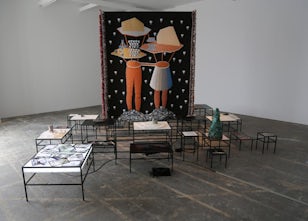
The insertion of her own body into the scene of the mine and in physically retracing the journey across the country, importantly stage an embodied ritual or gift to the lost copper. The gestures that Nkanga makes at the edge of the pit could be read as an embodied refusal of ‘prospecting as mass industrial ritual’,12remaking the rituals of colonial capitalism through embodied practices. Nkanga asks us to think through the intimacy of the connection of mining with the construction of the contemporary world. She highlights the deadly, and desirous, pursuits of bling.
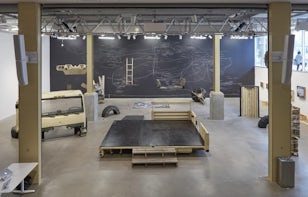
During the interview with the last managing director of the mine, Nkanga asks about the ‘black patch’ on the other side of the hill, behind the town. The black patch – a slag pile, the toxic waste from the still active copper refinery – is a visual reminder of the circulation of minerals as the pile often turns to dust, and the earth becomes air, perceived as a tickle in the throat. This tickle is also the marker of how, as Nicholas Mirzoeff writes, colonialism ‘is palpable to its ruled populations worldwide in terms of unbreathable air’.13 The mineral here is not as solid as we may believe it to be and the direct bodily connections between slag and our lungs stage another kind of embodied intimacy in relation to extraction.
What both these artists offer is a way to think with contemporary extractivist politics in manners that implicate, embody and intimately encounter the materials of exploitation. Instead of the anaesthetics that Mirzoeff characterises as emblematic of Anthropocene visuality – the production of images that serve to anaesthetise, rather than engage viewers – these artists are working with the intimacy of extraction.14 By refusing both the strategies of distanced photography as well as a too-easy critical distance, their affective and bodily working through provides a means to think about our entanglements with the violent rituals of industrialised capitalism. If extractivism and visuality are intimately linked, then both these artists are working, through various strategies and means, to reconnect to embodied practices of looking that deeply acknowledge our implications in the horrors of our times. Politically, this is of course, not enough. But it does offer a means through which to re-examine our relations to the mineralogical through practices that bind us to each other and to the earth.
Footnotes
-
Maggie Nelson, Bluets, Seattle and New York: Wave Books, 2009, p.3.
-
One of the most coveted minerals in the world, the price of cobalt fluctuated from 20,000 to 26,000 US dollars per ton in 2016. Meanwhile, the average ‘artisanal’ cobalt miner in the DRC earns 1 to 2 US dollars per day. For an extended examination of the human costs, including the deaths of children, due to cobalt mining, see the excellent Washington Post coverage, including Todd C. Frankel, ‘The Cobalt Pipeline: Tracing the path from deadly hand-dug mines in Congo to consumers’ phones and laptops’, Washington Post, 30 September 2016, available at https://www.washingtonpost.com/graphics/ business/batteries/congo-cobalt-mining-for-lithium-ion-battery/ (last accessed on 19 April 2019).
-
See ibid.
-
Alberto Acosta, ‘Extractivism and neoextractivism: two sides of the same curse’, in Miriam Lang and Dunya Mokrani (ed.), Beyond Development: Alternative Visions from Latin America, Quito: Transnational Institute/Fondación Rosa Luxemburg, 2013, pp.61–86, available at https://www.tni. org/files/download/beyonddevelopment_complete.pdf (last accessed on 19 April 2019).
-
Mary Mattingly, Own-It.US [website], available at http://www.own-it.us/html/about.html (last accessed on 19 April 2019).
-
A. Acosta, ‘Extractivism and neoextractivism’, op. cit., p.62.
-
Macarena Gómez-Barris, The Extractive Zone: Social Ecologies and Decolonial Perspectives, Durham, NC: Duke University Press, 2017, p.7.
-
Ibid.
-
See Donna Haraway, SF: Speculative Fabulation and String Figures, Ostfildern, Germany: Hatje Cantz Verlag, 2011.
-
Natasha Ginwala, ‘The Refusal of Shine’, in Clare Molloy, Philippe Pirotte and Fabian Schöneich (ed.), Otobong Nkanga: Luster and Lucre, Berlin: Sternberg Press, 2017, p.94.
-
Philippe Pirotte, ‘Foreword’, in Otobong Nkanga, op. cit., p.9
-
N. Ginwala, ‘The Refusal of Shine’, in Otobong Nkanga, op. cit., p.89.
-
Nicholas Mirzoeff, ‘Decolonial {R}evolution: Petrocracy and Geological Modernity from Detroit to Palestine and Back’, Asian Diasporic Visual Cultures and the Americas, vol.3, 2017, pp.322–43.
-
N. Mirzoeff, ‘Visualizing the Anthropocene’, Public Culture, vol.26, 2014, pp.213–32.
